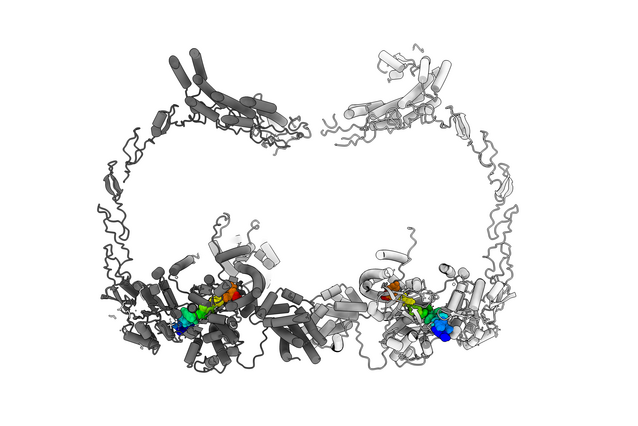ZNFX1 compacts and tags RNA to keep immunity in check
Tim Clausen’s lab at the IMP and collaborators have uncovered how the ancient immune protein ZNFX1 enables cells to walk the fine line between fighting infection and avoiding autoimmune damage. The team shows that ZNFX1 can ubiquitinate and compact host and viral RNA into molecular condensates, extending ubiquitin biology to RNA itself. Because inherited ZNFX1 mutations cause severe immune disease, the discovery sheds light on the roots of antiviral defence and possible paths to therapy. The findings were now published in the journal Cell.
Viruses are among the most persistent and dangerous threats to life. From common colds to devastating pandemics, they infiltrate cells and hijack the host’s machinery to replicate and spread. To counteract viral infections, organisms from plants and bacteria to humans have developed intricate defence systems to detect viral invaders and shut them down. However, if these systems are not tightly regulated, the immune system can overreact and attack the host leading to autoimmune disease. Studying this molecular balance is not only key to understanding immune regulation, but also to tackling medical challenges, from treating genetic immune diseases to developing antiviral therapies.
A new study published in Cell on August 27 adds a major piece to this puzzle. The research, led by Daniel Grabarczyk, a research associate in Tim Clausen’s lab at the Research Institute of Molecular Pathology (IMP), together with collaborators, sheds light on an ancient immune protein called ZNFX1 which sits in the middle of the balancing act between viral defence and autoimmunity.
ZNFX1’s importance is starkly illustrated in human health. Patients born with inherited mutations in ZNFX1 often suffer life-threatening viral infections and uncontrolled immune responses that can cause their own bodies to attack themselves. Despite this critical role, the precise molecular function of ZNFX1 had remained elusive—until now.
Packaging and tagging RNA to regulate immunity
To study ZNFX1’s function, the international team combined multiscale structural biology with enzymology and cell biology. They discovered that ZNFX1 binds directly to long RNAs, the messenger molecule to make proteins. Once bound, ZNFX1 packages the RNA and then initiates a highly unusual enzymatic reaction, attaching the small protein ubiquitin—which commonly marks proteins for degradation— to both itself and the RNA.
“Only after teaming up with Jacob Corn’s lab at ETH Zürich we realized the importance of this ubiquitination reaction for cell survival during an immune response,” comments Daniel Grabarczyk. “We believe that packaging and tagging the RNAs generated during an immune response may regulate the synthesis of viral and immune proteins, preventing viral replication and finetuning the immune response. We’re now trying to understand this process in detail,” adds Tim Clausen.
Linking viral defence to human health
Beyond providing fundamental insight on how cells respond to viral infections, the findings also have practical implications. Decoding how ZNFX1 uses ubiquitin signalling could inform the design of therapies for patients with immune deficiencies, as well as antiviral strategies in human medicine.
Original publication
Grabarczyk D.*, Arid E., Reznikow V., Kirchgatterer P., Ehrmann J., Kurzbauer R., Bell L., Kellner M., Aggarwal R., Schleiffer A., Faas V., Deszcz L., Meinhart A., Versteeg G., Penninger J., Stelzl L., Gaidt M., Tessmer I., Corn J., Clausen T.: “A Split-Site E3 Ligase Mechanism Enables ZNFX1 to Ubiquitinate and Cluster Single-Stranded RNA Into Ubiquitin-Coated Nucleoprotein Particles”. Cell. DOI: https://doi.org/10.1016/j.cell.2025.08.006
About the IMP
The Research Institute of Molecular Pathology (IMP) in Vienna is a basic life science research institute largely sponsored by Boehringer Ingelheim. With over 200 scientists from 40 countries, the IMP is committed to scientific discovery of fundamental molecular and cellular mechanisms underlying complex biological phenomena. The IMP is part of the Vienna BioCenter, one of Europe’s most dynamic life science hubs with almost 3000 employees from 80 countries in seven research organisations, two universities and over 45 biotech companies. www.imp.ac.at, www.viennabiocenter.org
